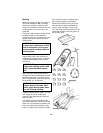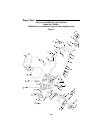
57
Motor
NOTE: Motors used on wood working tools are particularly susceptible to the accumu-
lation of sawdust and wood chips and should be blown out or “Vacuumed” frequently to
prevent interference with normal motor ventilation.
Trouble Probable Cause Remedy
Excessive Noise 1. Motor 1. Have motor checked by qualified
service technician. Repair ser-
vice is available at your nearest
Authorized Service Center.
Motor fails to
develop full
power. NOTE:
Low Voltage:
(Power output of
motor decreases
rapidly with
decrease in volt-
age at motor ter-
minals.
1. Circuit overloaded with lights,
appliances and other motors.
2. Wiring circuit (extension cord)
too long or undersize.
3. General overloading of power
company facilities. (In some
sections of the country,
demand for electrical power
may exceed the capacity of
existing generating and distri-
bution systems.)
4. Incorrect fuses or circuit
breakers in power line.
1. Do not use other appliances or
motors on same circuit when
using the saw.
2. Increase wire sizes, or reduce
length of circuit. See “Motor
Specifications and electrical
Requirements” section.
3. Request a voltage check from
the power company.
4. Install correct fuses or circuit
breakers.
Motor starts
slowly or fails to
come up to full
speed
1. Low voltage.
2. Windings burned out or open.
1. Request voltage check from the
power company.
2. Have motor repaired or replaced.
Motor overheats 1. Motor overloaded
2. Improper cooling. (Air circula-
tion restricted through motor
due to sawdust, accumulating
inside of saw.)
1. Feed work slower into blade.
2. Clean out sawdust to provide
normal air circulation through
motor. See “Maintenance” and
“Lubrication” section.
Motor stalls
(resulting in
blown fuses or
tripped circuit
breakers)
1. Voltage too low to permit
motor to reach operating
speed.
2. Fuses or circuit breakers do
not have sufficient capacity.
1. Request voltage check from the
power company.
2. Install proper size fuses or circuit
breakers.
Frequent open-
ing of fuses or
circuit breakers
1. Motor overloaded
2. Fuses or circuit breakers do
not have sufficient capacity.
1. Feed work slower into blade.
2. Install proper size fuses or circuit
breakers.
Motor runs inter-
mittently, sparks
excessively or
fails to start
1. Worn or damaged brushes 1. Replace brushes. See “Mainte-
nance” section.


















